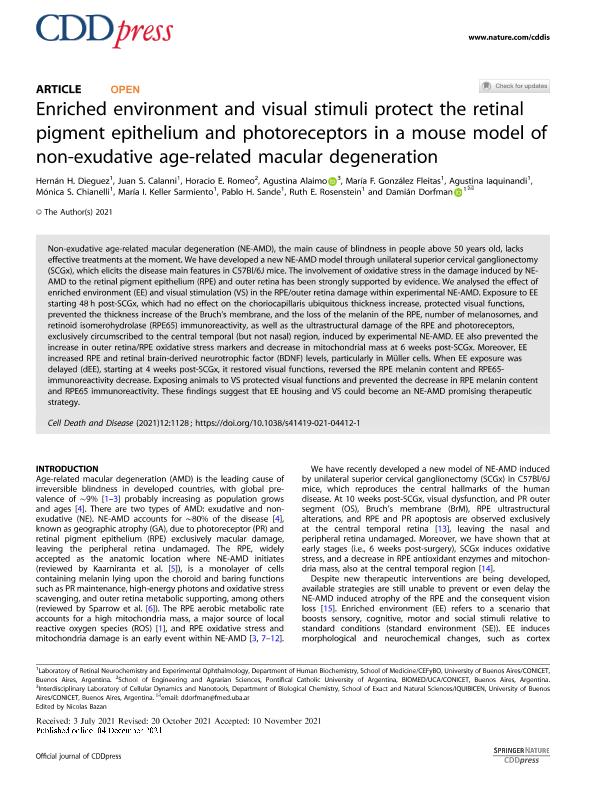Artículo
Enriched environment and visual stimuli protect the retinal pigment epithelium and photoreceptors in a mouse model of non-exudative age-related macular degeneration
Dieguez, Hernán ; Calanni, Juan Salvador; Romeo, Horacio Eduardo
; Calanni, Juan Salvador; Romeo, Horacio Eduardo ; Alaimo, Agustina
; Alaimo, Agustina ; González Fleitas, María Florencia
; González Fleitas, María Florencia ; Iaquinandi Murtagh, Agustina; Chianelli, Mónica Silvia
; Iaquinandi Murtagh, Agustina; Chianelli, Mónica Silvia ; Keller Sarmiento, María Inés
; Keller Sarmiento, María Inés ; Sande Casal, Pablo Horacio
; Sande Casal, Pablo Horacio ; Rosenstein, Ruth Estela
; Rosenstein, Ruth Estela ; Dorfman, Damián
; Dorfman, Damián
 ; Calanni, Juan Salvador; Romeo, Horacio Eduardo
; Calanni, Juan Salvador; Romeo, Horacio Eduardo ; Alaimo, Agustina
; Alaimo, Agustina ; González Fleitas, María Florencia
; González Fleitas, María Florencia ; Iaquinandi Murtagh, Agustina; Chianelli, Mónica Silvia
; Iaquinandi Murtagh, Agustina; Chianelli, Mónica Silvia ; Keller Sarmiento, María Inés
; Keller Sarmiento, María Inés ; Sande Casal, Pablo Horacio
; Sande Casal, Pablo Horacio ; Rosenstein, Ruth Estela
; Rosenstein, Ruth Estela ; Dorfman, Damián
; Dorfman, Damián
Fecha de publicación:
12/2021
Editorial:
Nature Publishing Group
Revista:
Cell Death and Disease
ISSN:
2041-4889
Idioma:
Inglés
Tipo de recurso:
Artículo publicado
Clasificación temática:
Resumen
Non-exudative age-related macular degeneration (NE-AMD), the main cause of blindness in people above 50 years old, lacks effective treatments at the moment. We have developed a new NE-AMD model through unilateral superior cervical ganglionectomy (SCGx), which elicits the disease main features in C57Bl/6J mice. The involvement of oxidative stress in the damage induced by NE-AMD to the retinal pigment epithelium (RPE) and outer retina has been strongly supported by evidence. We analysed the effect of enriched environment (EE) and visual stimulation (VS) in the RPE/outer retina damage within experimental NE-AMD. Exposure to EE starting 48 h post-SCGx, which had no effect on the choriocapillaris ubiquitous thickness increase, protected visual functions, prevented the thickness increase of the Bruch’s membrane, and the loss of the melanin of the RPE, number of melanosomes, and retinoid isomerohydrolase (RPE65) immunoreactivity, as well as the ultrastructural damage of the RPE and photoreceptors, exclusively circumscribed to the central temporal (but not nasal) region, induced by experimental NE-AMD. EE also prevented the increase in outer retina/RPE oxidative stress markers and decrease in mitochondrial mass at 6 weeks post-SCGx. Moreover, EE increased RPE and retinal brain-derived neurotrophic factor (BDNF) levels, particularly in Müller cells. When EE exposure was delayed (dEE), starting at 4 weeks post-SCGx, it restored visual functions, reversed the RPE melanin content and RPE65-immunoreactivity decrease. Exposing animals to VS protected visual functions and prevented the decrease in RPE melanin content and RPE65 immunoreactivity. These findings suggest that EE housing and VS could become an NE-AMD promising therapeutic strategy.
Archivos asociados
Licencia
Identificadores
Colecciones
Articulos(BIOMED)
Articulos de INSTITUTO DE INVESTIGACIONES BIOMEDICAS
Articulos de INSTITUTO DE INVESTIGACIONES BIOMEDICAS
Articulos(CEFYBO)
Articulos de CENTRO DE ESTUDIOS FARMACOLOGICOS Y BOTANICOS
Articulos de CENTRO DE ESTUDIOS FARMACOLOGICOS Y BOTANICOS
Articulos(IQUIBICEN)
Articulos de INSTITUTO DE QUIMICA BIOLOGICA DE LA FACULTAD DE CS. EXACTAS Y NATURALES
Articulos de INSTITUTO DE QUIMICA BIOLOGICA DE LA FACULTAD DE CS. EXACTAS Y NATURALES
Citación
Dieguez, Hernán; Calanni, Juan Salvador; Romeo, Horacio Eduardo; Alaimo, Agustina; González Fleitas, María Florencia; et al.; Enriched environment and visual stimuli protect the retinal pigment epithelium and photoreceptors in a mouse model of non-exudative age-related macular degeneration; Nature Publishing Group; Cell Death and Disease; 12; 12; 12-2021; 1-12
Compartir
Altmétricas



